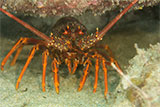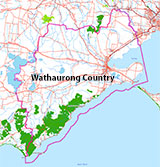Spot G
![]() Wall Dive |
Wall Dive | ![]() Boat access
Boat access
![]()
![]()
![]()
![]()
![]()
![]()
Depth: 20 m (66 ft) to 40 m (131 ft)
Named by a local diving identity, the Spot G dive site is remarkably hard to find. Some even say it doesn't exist, but it does. It's a stunning part of the Lonsdale Wall cliff system.
The wall here runs North to South with deeper water to the East. The wall has some huge splits or cracks in the area with a few pieces having broken away from the wall itself. This is wall diving at its best. Lots of fish and some incredible colours make this photographer's heaven.
Spot G, by Jane Headley.
Marine life to be found at Spot G includes Southern Blue Devil, Zebrafish, Giant Australian Cuttlefish, Southern Rock Lobster (aka Crayfish), Senator Wrasse, and Moonlighters.
The Rip & Tides Warning: Always keep an eye on sea conditions throughout any shore or boat dive within "The Rip" (aka "The Heads"). This is a dangerous stretch of water, where Bass Straight meets Port Phillip, which has claimed many ships and lives. Please read the warnings on the web page diving-the-rip before diving or snorkelling this site.
Lonsdale Wall
This dive site is one of many on Lonsdale Wall, located just inside The Heads on the Lonsdale side of Port Philip — one of Australia's premier dive locations. Lonsdale Wall is one side of an underwater canyon formed by the old Yarra River as it flowed out to sea through the plains, carving steep-walled edges out of soft rock sides. Between the end of the last Ice Age around 8000 BCE and around 6000 BCE, the sea-level rose to drown what was then the lower reaches of the Yarra River. Thus the canyon formed by the river near what is now The Heads, or The Rip, was flooded creating the Lonsdale Wall, North Wall and Nepean Wall areas. Lonsdale Wall extends for one kilometre, providing many spectacular dive sites. An almost vertical drop characterises Lonsdale Wall with the wall starting as shallow as 8 m (26 ft) metres deep in places and sometimes dropping down to well over 60 m (197 ft) deep. See also, Port of Melbourne Rip Map — Oblique seabed image of The Heads produced by hydrographic surveys.
Divers have the opportunity to catch Southern Rock Lobster (aka Crayfish) at this dive site. Remember your catch bag, current Victorian Recreational Fishing Licence, rock lobster measure, and cray tags. Once you get back to the dive boat, or shore, make sure you clip the tail and tag your Crayfish as per Fisheries requirements. Please abide by all current fishing regulations if you intend to catch crays. See article-catching-crayfish for practical cray hunting advice from The Scuba Doctor, plus melbourne-cray-dives for a list of other crayfish dive sites near Melbourne. For tips on cooking your Crays, please see article-cooking-crayfish.
Traditional Owners — This dive site is in the traditional Country of the Wathaurong (Wadda-Warrung) people of the Kulin Nation. This truly ancient Country includes the coastline of Port Phillip, from the Werribee River in the north-east, the Bellarine Peninsula, and down to Cape Otway in the south-west. We wish to acknowledge the Wathaurong as Traditional Owners. We pay respect to their Ancestors and their Elders, past, present and emerging. We acknowledge Bunjil the Creator Spirit of this beautiful land, who travels as an eagle, and Waarn, who protects the waterways and travels as a crow, and thank them for continuing to watch over this Country today and beyond.
Spot G Location Map
Latitude: 38° 17.404′ S (38.290067° S / 38° 17′ 24.24″ S)
Longitude: 144° 37.977′ E (144.63295° E / 144° 37′ 58.62″ E)
Datum: WGS84 |
Google Map
Added: 2012-07-22 09:00:00 GMT, Last updated: 2022-04-06 21:15:00 GMT
Source: GPS
Nearest Neighbour: The Swim Through, 12 m, bearing 107°, ESE
Depth: 20 to 40 m.
Dive only on: SWF, SWE.
[ Top ]
DISCLAIMER: No claim is made by The Scuba Doctor as to the accuracy of the dive site coordinates listed here. Should anyone decide to use these GPS marks to locate and dive on a site, they do so entirely at their own risk. Always verify against other sources.
The marks come from numerous sources including commercial operators, independent dive clubs, reference works, and active divers. Some are known to be accurate, while others may not be. Some GPS marks may even have come from maps using the AGD66 datum, and thus may need be converted to the WGS84 datum. To distinguish between the possible accuracy of the dive site marks, we've tried to give each mark a source of GPS, Google Earth, or unknown.



